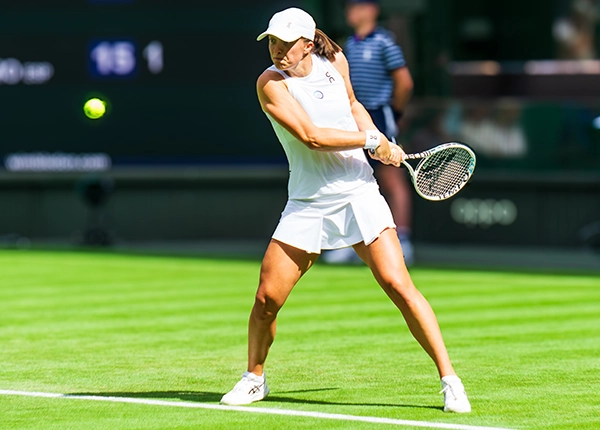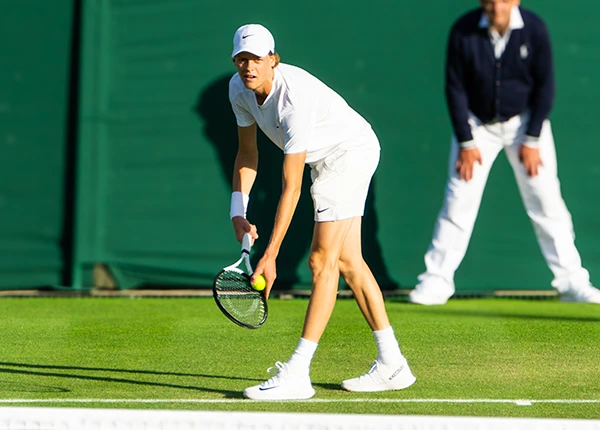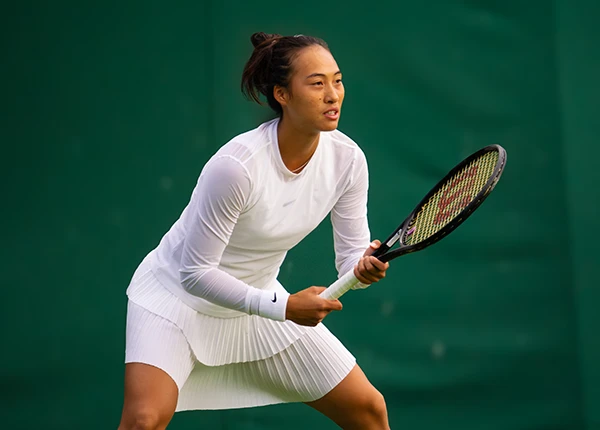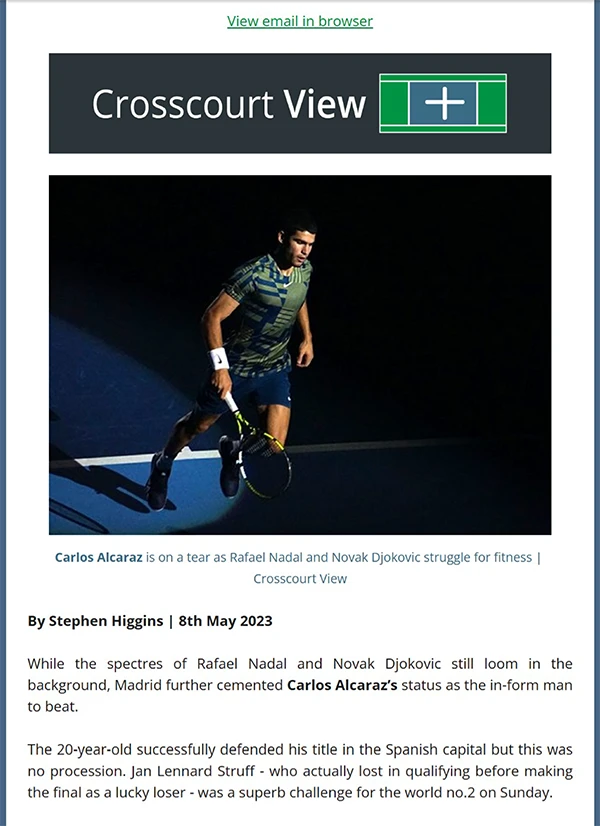Thoughts on Wimbledon 2025
Swiatek soars on the grass, Jannik holds his nerve and the Beeb can do better

Iga dumps her Wimbledon baggage
After questions over her confidence, form and coaching setup for the past year, Iga Swiatek ended her barren run at SW19 of all places. While a junior champion at Wimbledon back in 2018, the Pole had only once made the last eight as a professional before 2025.
However, a fresh approach this year - including a training block on Mallorcan grass - transformed Swiatek’s fortunes at the All England Club. Given all that she has accomplished, we shouldn’t really be surprised by what the 24-year-old can do on a tennis court. But I was highly impressed with how well she played over the fortnight. Apart from a ropey first set against Caty McNally, Iga demolished the field and only coughed up two games across both the semi and final.
Going into the championship match, you wondered if the former world no.1’s incredible final record (22-5) would be decisive. It certainly was in the end as she swatted poor Amanda Anisimova aside in less than an hour. I remember watching the Rome final in 2021, when she double-bageled Karolina Pliskova, and the Wimbledon final had a similar vibe.
Swiatek was ruthless and her serve was incredible as the tournament went on. Did you know that she fired one down at 194 km/h (120 mph) during the final?! After a year without a title, Iga is back and primed to resurrect her rivalry with Aryna Sabalenka atop the rankings. One more thing, she's only an Australian Open away from the career grand slam.
Sublime Sinner holds his nerve and invigorates rivalry
'Nobody beats Jannik Sinner six times in a row' may have been the motto that swirled around the Italian's head, a la Vitas Gerulaitis. For while the world's top two have separated themselves from the pack over the past couple of seasons, Alcaraz has had the measure of Sinner over the same period.
Now, after that stunning and heartbreaking defeat to the Spaniard in Roland Garros, Sinner had to overcome his great rival on Alcaraz's best surface. It was a tall order but the 23-year-old went about the task in his usual unfussy, but ruthlessly effective style.

We all know that Alcaraz can reach extraordinary heights, but that these moments tend to be fleeting. Meanwhile, Sinner plays within a narrower range of excellence - possibly not as high as the Spaniard, but also never as low. That consistency proved decisive as Alcaraz, possibly through fatigue, could not reach top gear apart from that flourish at the end of set one.
Instead, Sinner's better serving, relentless pressure on return, and aggressive mindset took the contest away from the two-time Wimbledon champion. By the time we reached set four, the man with the greatest arsenal in tennis seemed short of ammunition.
In truth, the rivalry needed more balance in the head-to-head and across the surfaces. We now know that Sinner can beat Alcaraz on grass. So maybe clay is a possibility down the line too? It's the fourth major title for the Italian and his third in the last four grand slams. He was only a match point away from a Sinner slam. There's no doubt that both these men are on course for eternal greatness...but let's give pause. For Sinner to match Novak Djokovic's grand slam collection, he will need to secure two majors a season for the next decade. It's possible of course, but let's see how things develop in the years to come.
Amanda Amazes
I could dwell on the historical nature of the American’s defeat, but I won’t because I really like Anisimova as a player, and admire her resilience as a person. Beating Swiatek in a final is a tall order in any context, but if you start nervously and struggle to gain traction, the Pole will show no mercy.
Hopefully, the 23-year-old who possesses one of the world’s great backhands can take encouragement from her deepest run yet at a grand slam and an impressive victory over the world no.1.
Now in the top 10 and enjoying her best season to date after that WTA 1000 victory earlier in the year, Anisimova has the chance to kick on and really leave a mark on the North American hard courts. Having never made it past the third round in Flushing Meadows, that seems like a good target to end the summer with.
How will Carlos respond to Sinner's shift?
Given the ridiculous level of play that Carlos Alcaraz has produced since April, it seems harsh to even point out issues from his final performance. However, he is chasing gods and after some rest will surely retreat to a video room and tennis court to work on future plans with Juan Carlos Ferrero and Samuel Lopez.
While Sinner was superb for the vast bulk of the final, the key areas that hurt Carlos were his first serve percentage and those notorious concentration lapses. The Spaniard's first delivery averaged 53% for the match, and dropped as low as 43% in set three. No one can afford such a low percentage when facing the best returner on tour these days.
As for the lapses, it takes supreme concentration to stay with the Italian but that is what is required at the level we are witnessing. Alcaraz dipped at crucial parts of the match and because the first strike is so much more pivotal on grass than clay, it was much more costly to the 22-year-old.
Since there is a high probability of another Sinner-Alcaraz showdown in the near future, it will be intriguing to see how the Spaniard adjusts his game in this burgeoning rivalry.
Opportunity knocks for Wimbledon women
There was extraordinary carnage on the women’s side this year as no fewer than 10 seeds crashed out in round one, including top five stalwarts Coco Gauff, Jessie Pegula and Qinwen Zheng. While Gauff can be forgiven for the underperformance after her Parisian success, the early exits of Pegula and Zheng are puzzling.

The American actually came to London fresh from toppling Swiatek in the final of Bad Homburg, but was still upset by Elisabetta Cocciaretto. As for the Olympic champion, this is her third straight first round defeat at SW19. Given her immense power and athleticism, surely there is a formula for Zheng to do well on grass?
While many players struggle to excel on the turf, grass arguably presents the best opportunity for success if you can adapt your game to it. There has been a different women’s champion each year since 2017. And while everyone plays well on hard courts and clay, there is a much smaller pool who feel comfortable at the All England Club.
Maybe more WTA players should look at taking a Swiatek-style excursion to Mallorca before the Championships?
Sandwich generation can learn from their forebears
Before the second round had even kicked off, we had said goodbye to Alexander Zverev and (via retirement) Stefanos Tsitsipas. The German first made the fourth round of Wimbledon in 2017, while the Greek made the same stage a year later. Could you have imagined back then that neither player would better those showings in the years ahead? Then there's poor Casper Ruud. The three-time major finalist, who missed this year’s tournament with a knee issue, has never made it past the second round at SW19.
What’s going on here? While you can (attempt to) argue that Zverev’s extreme forehand, and Ruud’s clay-oriented game are a bad fit for the grass, what’s Stefanos’ excuse? With his potent serve, enormous forehand and excellent touch, how has the Greek not made a big impression at the All England Club? Plus, as we know by now, the grass courts of today are playing much more like slow hard courts than the lightning surface of Sampras and Becker.
I mention this because we often tend to over and underestimate players beyond the Big Four or Sinner/Alcaraz. If we step back a decade in the rankings, surely the rest of the top 10 had similar issues performing on the hallowed lawns?
Not quite.
While grass was clearly his worst surface, Stan Wawrinka still made the last eight at Wimbledon on two occasions. As did David Ferrer and the oft-injured Kei Nishikori. Richard Gasquet and Jo Wilfried Tsonga both made the semi-finals a couple of times a piece. When you move beyond the top 10, it gets even stronger as we find John Isner (semi-finalist), Kevin Anderson (finalist), Marin Cilic (finalist) and Milos Raonic (finalist) ranked 11th to 14th.

Remember that all of these players competed in the prime periods of Djokovic, Nadal, Federer and Murray and (generally) achieved their best results on other surfaces.
Maybe a reappraisal is needed? While we justifiably laud the Big Four for all their achievements, we could throw a little more credit towards the guys they faced.
Anyone for Beeb bashing?
Because I was in or around Wimbledon during the first week, I thankfully was spared too much of the BBC’s coverage. It was in the second week that I had to slip back into their tiresome offering.
Technically, the Championships look as great as ever. But why the persistence with Clare Balding as lead presenter when someone with a tennis background would suit better? Why the obsession with the pretentious poetry before matches? Why the mundane questions on court after contests finish?
That said, the real obsession for commentary that needs curtailing is the Royal Box. Stop cutting to it at every break in play. I don’t care if Leonardo Di Caprio is at ‘the tennis’. I’m glad to see he has taste, but I don’t need his presence there as validation that the tournament is worth watching.
A real low point came in the semi-final between Carlos Alcaraz and Taylor Fritz. Andre Agassi appeared in the commentary booth for the first time at the event and he delivered brilliant insight as expected. Andrew Castle and Tim Henman seemed bowled over by his deep analysis but just as he was about to explain how Fritz had changed the flow of the contest, Castle interrupted to talk about people in the Royal Box as if that mattered a jot. Thankfully, at least producers still utilise the peerless Tracy Austin for women’s matches and I always have time for Sam Smith and Daniela Hantuchova.
But if we are being honest, shouldn’t the most revered tournament on the tennis calendar have better coverage?

